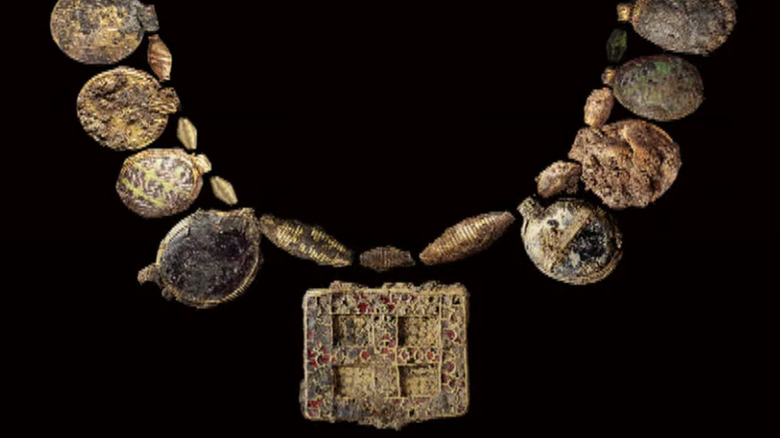What Does A Necklace Found At An English Burial Site Tell Us About Ancient Women In Power?
An old necklace uncovered in 2022 offers fascinating insight into the Anglo-Saxon era of English history, and particularly what life was like for powerful women who lived in that time period, according to CNN. The necklace is part of the Harpole Treasure, named for the area of Northamptonshire county where the necklace and other items were found. The ornate necklace turned up in what was once a burial site but is now slated for housing. Scientists say it is around 1,300 years old, putting it squarely from the middle of the Anglo-Saxon period in England, which is defined by the fall of the Roman empire in the fifth century to the Norman Conquest of 1066, as the BBC explains.
In this era, Christianity was just taking hold in the British isles, and evidence suggests that the necklace found in the Harpole Treasure once belonged to a woman who played a part in Christianity's development in the region. RPS archaeology consultant Simon Mortimer said in a statement, "This find is truly a once-in-a-lifetime discovery — the sort of thing you read about in textbooks and not something you expect to see coming out of the ground in front of you."
The necklace was made from Roman coins
As The New York Times reports, the Harpole Treasure necklace was made from Roman coins, with gold, garnets, and glass. Also included in the jewelry's construction are an assortment of semi-precious stones. At the center sits a large cross pendant. As the RPS statement announcing the find also stated, two pots and a shallow copper dish were also uncovered in the dig. Among the most notable of all the artifacts uncovered is a large cross with human faces rendered in silver.
The woman buried with the items has all but disappeared through natural processes, beyond fragments of tooth enamel. Research to identify any other possible remaining organic elements is ongoing. Museum of London Archaeology site supervisor Levente-Bence Balázs said in the RPS statement, "When the first glints of gold started to emerge from the soil we knew this was something significant. However, we didn't quite [realize] how special this was going to be."
The woman who owned the necklace was likely an early church leader
As CNN points out, similar burial sites of women known as "bed burials" from around the same time period have been found in England, but the Harpole Treasure is from one of the earlier ones. Moreover, most graves uncovered from the Anglo-Saxon period were for men, and the fact that the Harpole Treasure belonged to a woman that was likely an early Christian church leader makes the find all that much more remarkable. The necklace also seems somewhat an exception from the time period as opulent jewelry was overall looked down on by the early Christian church, according to CNN.
Lyn Blackmore, senior finds specialist at the Museum of London Archaeology, said (via CNN): "The Harpole Treasure, it's not the richest (bed burial) in terms of the number of artifacts but it is the richest in terms of investment of wealth ... and it has the highest amount of gold and religious symbolism." Organic traces of leather and feathers have also been found on the site. Construction on the housing development on the site has continued, and after further research, the Harpole Treasure artifacts will likely go on public display. Historical theologian at Gordon College, Amy Brown Hughes said of the find (via The Times): "Her burial demonstrated that this was a woman who was respected as a Christian, known for her devotion, and had some level of authority and influence."


